Chapter 1 – Teradata for Executives
“I saw the angel in the marble and carved until I set him free.”
-Michelangelo
Who is the Most Important Person in a Data Warehouse?
“The future belongs to those who believe in the beauty of their dreams.”
- Eleanor Roosevelt

If you are an executive reading this book then the answer to that question is you! Executive support is the biggest factor for success in any data warehouse. You’ve been hired and have risen to the position you are in because you are special. You have proven your talent, intelligence and business savvy. Brilliance, like rain, flows downhill so do your organization a huge favor and guide the warehouse with proper steps. That is why I created the “Genius Series” so that everyone can learn from my twenty years of Teradata experience and discover the tools of the trade to maximize this opportunity. This book is dedicated to you, the executive. Does this book cover what the most successful companies using Teradata are doing? No. This book will show you how to beat them with advanced strategies that even the best haven’t discovered!
The Basics of a Single Computer
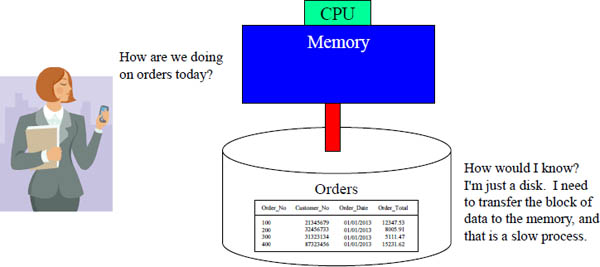
Data on disk does absolutely nothing. When data is requested, the computer moves the data one block at a time from disk into memory. Once the data is in memory, it is processed by the CPU at lightning speed. All computers work this way. The “Achilles Heel” of every computer is the slow process of moving data from disk to memory. That is all you need to know to be a computer expert!
What is Parallel Processing?
“After enlightenment, the laundry”
- Zen Proverb

“After parallel processing the laundry, enlightenment!”
-Teradata Zen Proverb
Two guys were having fun on a Saturday night when one said, “I’ve got to go and do my laundry.” The other said, “What?!” The man explained that if he went to the laundry mat the next morning, he would be lucky to get one machine and be there all day. But, if he went on Saturday night, he could get all the machines. Then, he could do all his wash and dry in two hours. Now, that’s parallel processing mixed in with a little dry humor!
Each AMP is Responsible for a Portion of the Data
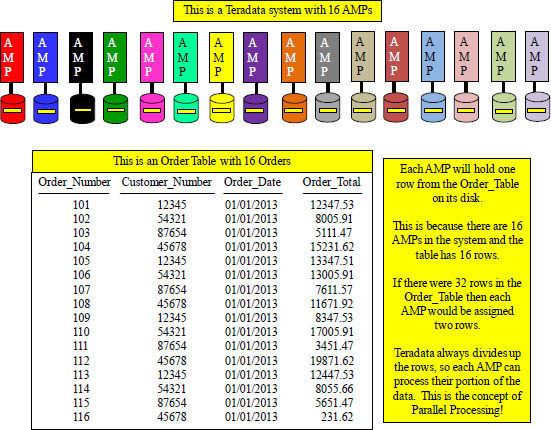
Teradata systems spread the rows from each table across all the Access Module Processors (AMPs).
Each AMP holds a Portion of Every Table
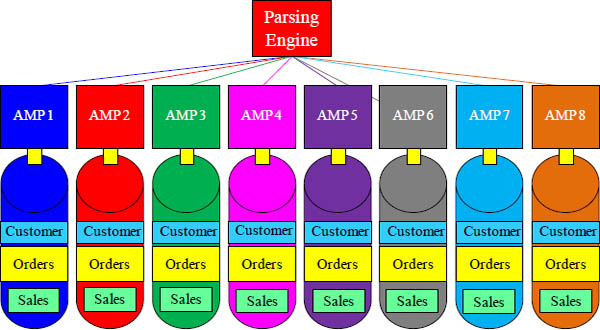
Every AMP has the exact same tables, but each AMP holds different rows of those tables.
When a table is created on Teradata, each AMP receives a Table Header, so each AMP has the exact same table structures. When data is loaded though, the rows are distributed so each AMP holds a certain portion of the rows. If the Parsing Engine orders a full table scan of a particular table, then all AMPs simultaneously read their portion of the data. This is the concept of parallel processing. If everyone does an equal amount of the work at the same time, then the job is eight times faster.
The Teradata Architecture
“A Journey of a thousand miles begins with a single step.”
- Lao Tzu

The Parsing Engine (PE) is the brains behind every Teradata system. It ingeniously guides the AMPs like a conductor in an orchestra. In the movie Forrest Gump, Forrest’s sergeant asked him, “What is your job Gump?” Forrest replied, “To do whatever you tell me to do, sir”. “Brilliant Gump”, was his response. The Parsing Engine asks the AMPs the same question and they give the same response. The Parsing Engine also takes care of every user. Every time someone logs into Teradata they are directed to a Parsing Engine (PE). The Parsing Engine handles every user query. The PE first checks to see if the user has the security access to see the table they are querying. If they have the access rights, the Parsing Engine will take their query and come up with a plan for the AMPs to follow. The Parsing Engine will pass the plan over the BYNET network and each AMP will perform their portion of the work. The Parsing Engine will receive the data from each AMP and pass it back to the user. The PE is the boss and the AMPs are the workers.
Understand the Extremes of Teradata
“It’s kind of fun to do the impossible.”
-Walt Disney
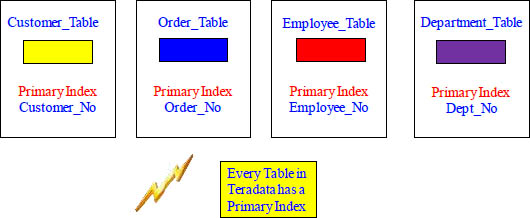
Teradata has brilliantly mastered two extremes. Of course you already know that Teradata can analyze massive amounts of data because of their parallel processing capabilities, but did you know that Teradata can find a single record in under a second, no matter how much data is stored?
Every table in Teradata has one column designated as the Primary Index. When users want to find a single record quickly, and their query looks up data using the Primary Index, then only one AMP is read. Build your warehouse knowing of these two extremes. Teradata is brilliant at finding data in less than one second. These are called Tactical Queries, but they are also the best at parallel processing Terabytes of information.
Teradata has TASM – A Sophisticated Traffic System
“Two roads diverged in a wood and I took the one less traveled by, and that has made all the difference.”
- Robert Frost
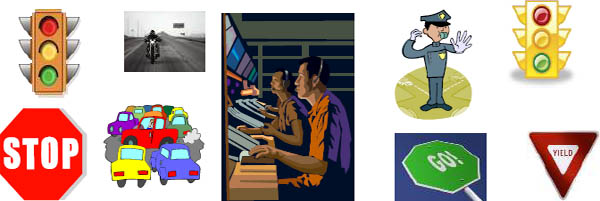
Imagine our highways with only one lane or roads with no stop signs or lights. Teradata has the most sophisticated traffic system in the industry. Teradata allows you to setup rules, with green lights to query and red lights to wait. Why put a long-haul trucker with an oversized load in the fast lane? Marathon runners don’t run at the same speed as sprinters, so you need to give your fastest speeds to your tactical queries and slower speeds for your batch processing. Teradata Active System Management (TASM) controls the query traffic so users can take the route less traveled. Get a handle on your users and their needs. I have placed them in four major categories.
There are Four Major Types of Users
“Where there is no patrol car, there is no speed limit.”
- Al Capone
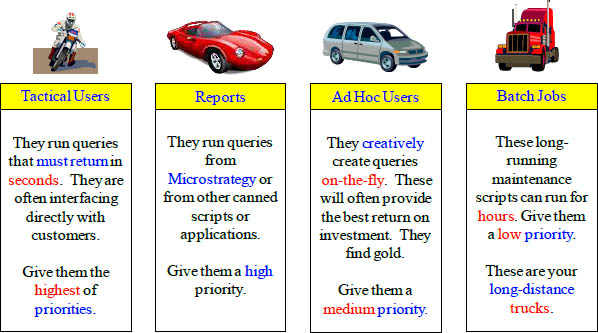
All users are not created equal. Configure your system the way you like to drive your car on the highway. There are those that need to be in the fast lane, those that need to be in the middle lane and those that need to stay in the right lane. Too many big trucks slow down everything. You have low (right lane), medium (middle lane), high (left lane) and rush (HOV lane) priorities. Use them wisely and your system will benefit.
